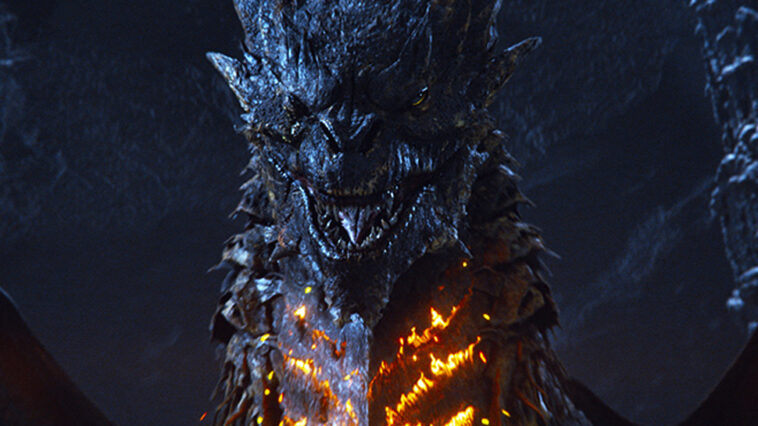When a young bride becomes an unexpected offering to a dragon, both the creature and the royal family that betrayed her get more than what they bargained for as she has no intention of carrying on the sacrificial tradition. This is the premise for the Netflix production of Damsel directed by Juan Carlos Fresnadillo (Intruders) and starring Millie Bobby Brown, Ray Winstone, Nick Robinson, Shohreh Aghdashloo, Angela Bassett and Robin Wright. Dividing the visual effects work for the dark fantasy feature were supervisors Nigel Denton-Howes and Nicholas Brooks. “I came in at the beginning of post-production to help bring the dragon along because my background is doing creature stuff,” Denton-Howes states. “The original supervisor was more of an environments person.”
“Our dragon is much closer to a panther, which is why when we brought her into the environments and caves, she is just as comfortable running around the caves as she is flying around them. Whereas your stereotypical dragon is lumbering on the ground and graceful in the air.”
—Nigel Denton-Howes, Visual Effects Supervisor.
Responsible for the production design was Patrick Tatopoulos. who has made a name for himself as a creature designer. “Patrick was brought back as well in post, which is unusual,” Denton-Howes notes. “I managed to get him to work with the artists at One of Us, and I finished off the look development and all of the details that are needed to make [the dragon] look real when you get into the shots.” The desire was not to go for a lizard-inspired dragon like Game of Thrones. “Our dragon is much closer to a panther, which is why when we brought her into the environments and caves, she is just as comfortable running around the caves as she is flying around them. Whereas your stereotypical dragon is lumbering on the ground and graceful in the air,” Denton-Howes explains. Tatopoulos’ designs for the dragon were refined with the original version having a strong graphical orange line going down the flanks and back of the neck. “We followed the line to the spine and tail. That allows her to stand out in the caves. But the whole textural approach is that she is part of this environment and is supposed to blend in,” Denton-Howes says.




Shohreh Aghdashloo provides the voice of the dragon. “There are certain sounds that are awkward for a mouth that big and a muzzle that long to make,” Denton-Howes remarks. “There is some lip sync, and we’re using the jaw a lot, but a lot of the motion and mechanics were actually done with the neck. When she inhales, the neck plates open, and it compresses like bellows when she exhales. We added a shiver to the neck plates to correspond to her emotional state. When she is confident, there is very little flutter in them and when she gets angry, they vibrate like crazy. That informed the sound design.” Something unusual for Denton-Howes was getting an opportunity to work directly with the sound design team. “We did a bunch of loops back and forth of animation and sound tests until we got a final dialogue sound that was going to work.”
Environments were enhanced to get a proper interaction with the dragon. “A lot of the environments are CG, but on the sets that were built we added all of the rocks and debris on top of them because they were actually bare,” Denton-Howes says. “When the dragon is walking, she can kick stones, and everything extended in the background is CG. When she is interacting with characters, like when one of the guards gets grabbed, it’s a takeover into an all-CG character. For some of them, the whole shot is CG. When we’re interacting with Millie, like when the dragon’s hand is on her neck, on set there were interactive elements such as claws that could press down to allow her to feel some of it. Then we also bent her skin in 2D to add indentations, and, in the dragon, there was some modeling to push in the pads of the thumbs and fingers to make them squishy so you can feel that the two are really touching each other.” Each cave was distinct. “One had stalactites and stalagmites. The main action area has giant columns and looks like a cathedral. Then there is the crystal cave that Millie climbs up. It’s done so you don’t feel as if you’re in the same place all of the time.”


Primary vendors for the 1,202 visual effects were One of Us, who was responsible for the dragon, Rodeo FX, who did a lot of environments and glow worms, Pixomondo, who handled the dragon, dragon lair, the opening and end sequences, and Important Looking Pirates, who created the harbor environment and Elodie’s homeland. Other contributions came from The Yard VFX, Rising Sun Pictures, Rebel Unit, Atomic Arts, Primary VFX, NetFX and TPO VFX. “Later in reshoots, we added the opening scenes of Elodie’s homeland as visual contrast, as well as for storytelling reasons,” Denton-Howes states. “When you get into Aurea, it needs to look realistic but really lush and beautiful. In the grade, [director] Juan Carlos Fresnadillo pushed it into gold and warmed things up even further, which is a subtle change.”
